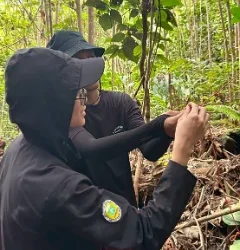GAIA, Southeast Asia is home to some of the most biologically rich ecosystems on Earth. From the dense rainforests of Borneo to the vibrant coral reefs of the Coral Triangle, the region boasts extraordinary biodiversity. However, this natural wealth is under threat due to deforestation, mining, urbanization, and climate change.
As governments and businesses seek sustainable pathways to balance economic growth with environmental preservation, biodiversity credits are emerging as a powerful solution. By assigning economic value to conservation efforts, biodiversity credits offer a market-based mechanism to finance restoration, protect species, and promote sustainable development across Southeast Asia.
What Are Biodiversity Credits?
Biodiversity credits are tradable units that represent verified actions to conserve or restore natural ecosystems. These may include reforestation, mangrove rehabilitation, species habitat protection, or the restoration of degraded wetlands. Companies or institutions can purchase these credits to offset the ecological impacts of their operations or to voluntarily support biodiversity goals.
In Southeast Asia—where biodiversity loss often goes hand in hand with industrial development—this mechanism offers an innovative way to fund conservation while driving inclusive economic growth.
Why Southeast Asia Is Key for Biodiversity Credits
- Global Biodiversity Hotspot
Southeast Asia contains 20% of the planet’s plant and animal species, despite covering only 3% of Earth’s surface. Indonesia, Malaysia, the Philippines, and Vietnam are among the world’s megadiverse countries, making the region crucial for any global effort to protect biodiversity. - High Development Pressure
Rapid infrastructure expansion, agricultural conversion, and extractive industries pose ongoing threats to natural ecosystems. Biodiversity credits can help mitigate the impact of development, allowing governments and corporations to balance growth with conservation. - Strong Community Involvement
Many Southeast Asian communities, including Indigenous groups, have lived sustainably with nature for generations. When implemented equitably, biodiversity credit projects can empower local communities, provide jobs, and strengthen traditional conservation practices. - Climate Change Mitigation Co-Benefits
Projects like forest and mangrove restoration not only protect biodiversity but also absorb carbon, reduce flood risks, and increase climate resilience—supporting both biodiversity and climate adaptation goals.
How Biodiversity Credits Work in Southeast Asia
Biodiversity credits in the region are typically developed through partnerships between project developers, local communities, scientists, NGOs, and government agencies. These projects are verified by international standards, such as:
- Verra (VCS and CCB Standards)
- Science Based Targets for Nature (SBTN)
- Taskforce on Nature-related Financial Disclosures (TNFD)
Once credits are verified, they are sold to buyers—often corporations in high-impact sectors like palm oil, mining, construction, or manufacturing—looking to offset their biodiversity footprint or enhance their ESG profiles.
Case Example: Gaia’s Biodiversity Credit Projects in Southeast Asia
A leading developer in this space is Gaia, a nature-based solutions company that specializes in biodiversity and carbon credit projects across the region. Gaia partners with local governments and Indigenous communities to implement large-scale conservation efforts that meet both ecological and economic objectives.
In Indonesia, Gaia has launched mangrove restoration projects that not only regenerate marine biodiversity but also boost fisheries and protect coastal villages from erosion. In the Philippines, Gaia is working on protecting endangered species’ habitats through community-led forest patrols and ecosystem monitoring.
These initiatives show how biodiversity credits can align environmental protection with sustainable livelihoods, ensuring long-term impact and stakeholder engagement.
Challenges Facing Biodiversity Credit Development in Southeast Asia
Despite the promise, there are several challenges to building a robust biodiversity credit market in the region:
- Regulatory Uncertainty
While countries like Indonesia and Malaysia are exploring biodiversity credit frameworks, clear policies and legal guidelines are still developing. - Measurement Complexity
Biodiversity is far more complex than carbon. Measuring ecological gains and ensuring additionality (i.e., ensuring the gains wouldn’t have occurred without the project) is technically challenging and site-specific. - Risk of Greenwashing
Without credible verification and transparency, biodiversity credits can be misused by corporations to mask ongoing environmental damage.
Ensuring Community Inclusion
Projects must prioritize Free, Prior, and Informed Consent (FPIC) and ensure benefit-sharing to avoid displacing or excluding local and Indigenous communities.

The Road Ahead: Building a Sustainable Biodiversity Credit Market
To fully unlock the potential of biodiversity credits in Southeast Asia, stakeholders must focus on:
- Strengthening policy frameworks at national and regional levels
- Investing in monitoring and verification technologies
- Fostering partnerships between public and private sectors
- Empowering local communities as equal stakeholders
Regional cooperation—such as through ASEAN biodiversity initiatives—can also help standardize approaches and ensure alignment with global targets like the Kunming-Montreal Global Biodiversity Framework, which calls for protecting 30% of land and sea areas by 2030.
Conclusion
Biodiversity credits represent a powerful pathway for Southeast Asia to achieve sustainable development that protects both people and the planet. By monetizing ecological restoration and involving local communities, they bridge the gap between conservation and commerce.
While challenges remain, responsible development of biodiversity credit markets—driven by transparency, science, and equity—can help Southeast Asia lead the world in nature-positive growth. And with innovators like Gaia paving the way, the region is well-positioned to turn its rich biodiversity into a foundation for lasting prosperity.
Sources Referenced
- UNEP (2022). State of Finance for Nature 2022. Retrieved from https://www.unep.org/resources/state-finance-nature-2022
- Science Based Targets Network (SBTN). Official Website. Retrieved from https://sciencebasedtargetsnetwork.org
- ASEAN Centre for Biodiversity. Official Website. Retrieved from https://aseanbiodiversity.org
- Convention on Biological Diversity (COP15). Official Website. Retrieved from https://www.cbd.int





